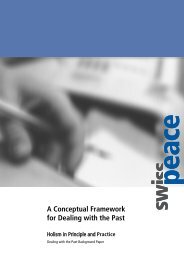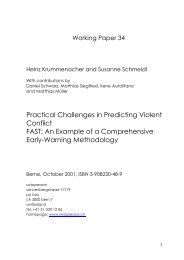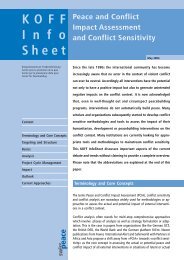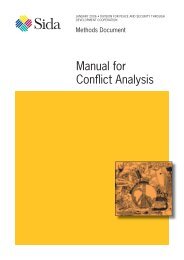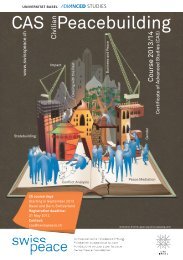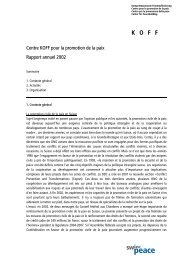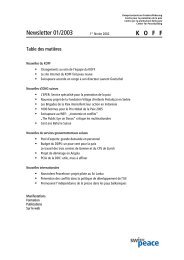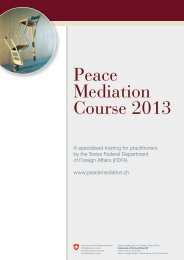Unpacking the Mystery of Mediation in African Peace ... - Swisspeace
Unpacking the Mystery of Mediation in African Peace ... - Swisspeace
Unpacking the Mystery of Mediation in African Peace ... - Swisspeace
Create successful ePaper yourself
Turn your PDF publications into a flip-book with our unique Google optimized e-Paper software.
“If you want to make peace with your enemy, you have to<br />
work with your enemy. Then he becomes your partner.”<br />
<strong>Mediation</strong> <strong>in</strong> <strong>African</strong> <strong>Peace</strong> Processes:<br />
Carefully Compar<strong>in</strong>g Apples and Oranges<br />
By Simon J A Mason, <strong>Mediation</strong> Support Project, Center for Security Studies, ETH Zurich<br />
Introduction<br />
<strong>Mediation</strong> is a mystery. Some peace processes are<br />
successful, some are dismal failures, and most are<br />
a bit <strong>of</strong> both. The transition <strong>of</strong> a society from<br />
war to peace is extremely complex and difficult.<br />
Conflict parties use military means to reach <strong>the</strong>ir<br />
aims, sometimes kill<strong>in</strong>g thousands or tens <strong>of</strong><br />
thousands <strong>of</strong> people <strong>in</strong> <strong>the</strong> process. Dur<strong>in</strong>g a<br />
peace process, conflict parties may slowly realize<br />
that <strong>the</strong>y can ga<strong>in</strong> more from negotiat<strong>in</strong>g than<br />
from fight<strong>in</strong>g. This takes time, however. It also<br />
takes people who talk to <strong>the</strong> conflict parties to<br />
try and understand <strong>the</strong>ir motives and <strong>in</strong>tentions,<br />
and why <strong>the</strong>y have chosen arms as <strong>the</strong>ir means <strong>of</strong><br />
settl<strong>in</strong>g issues.<br />
There is no ethical reason for refus<strong>in</strong>g to talk<br />
even to <strong>the</strong> world’s worst human rights violators<br />
if <strong>the</strong>reby lives can be saved, and if this helps to<br />
transform a war-torn society <strong>in</strong>to a society mov<strong>in</strong>g<br />
towards peace, justice, and democracy. On<br />
<strong>the</strong> contrary, <strong>the</strong>re are good ethical reasons for<br />
talk<strong>in</strong>g to such people, even if <strong>the</strong> task is a delicate<br />
and very difficult one. The decision <strong>of</strong> talk<strong>in</strong>g<br />
or not, however, must also be based on case<br />
by case pragmatic and political considerations,<br />
not only on ethical ones. 1 This challenge is one<br />
reason why mediation <strong>in</strong> contemporary peace<br />
1 UN Special Representative <strong>of</strong> <strong>the</strong> Secretary General, Lakhdar<br />
Barhimi argues for this pragmatic approach: “If you accept<br />
<strong>the</strong>se k<strong>in</strong>ds <strong>of</strong> jobs, you go and mediate between warlords, faction<br />
leaders, bandits, all sorts <strong>of</strong> people, people whom <strong>the</strong> human<br />
rights purists want to see hang. What I tell <strong>the</strong>m is ‘Let<br />
me f<strong>in</strong>ish, and <strong>the</strong>n go ahead and hang <strong>the</strong>m.’” He was also<br />
asked if he would talk to Osama b<strong>in</strong> Laden. “If I were to mediate<br />
between Al Qaeda and <strong>the</strong> United States, I suppose I<br />
would have to. But we are not <strong>the</strong>re yet, are we? And Osama<br />
would refuse to talk to me, you have to remember that.” Mart<strong>in</strong>,<br />
Harriet: “K<strong>in</strong>gs <strong>of</strong> <strong>Peace</strong>, Pawns <strong>of</strong> War: The Untold<br />
Story <strong>of</strong> <strong>Peace</strong>-Mak<strong>in</strong>g”, London, New York: Cont<strong>in</strong>uum International<br />
Publish<strong>in</strong>g Group (2006), p.25-26.<br />
Nelson Mandela<br />
processes is surrounded by a certa<strong>in</strong> mysterious<br />
aura. Simple answers are out <strong>of</strong> place, and it is not<br />
helpful to exam<strong>in</strong>e mediation as a purely technical<br />
or academic topic. Never<strong>the</strong>less, it is also wrong to<br />
endow mediation with excessive mystification,<br />
thus plac<strong>in</strong>g it beyond <strong>the</strong> bounds <strong>of</strong> systematic<br />
research and learn<strong>in</strong>g.<br />
Aim and rationale: The aim <strong>of</strong> this study is to<br />
partially “unpack” <strong>the</strong> mystery <strong>of</strong> mediation, <strong>in</strong><br />
order to learn about <strong>the</strong> use <strong>of</strong> mediation <strong>in</strong> <strong>African</strong><br />
peace processes dur<strong>in</strong>g <strong>the</strong> last decade. Ultimately,<br />
<strong>the</strong> goal is to provide better support for<br />
ongo<strong>in</strong>g and future mediation efforts <strong>in</strong> such<br />
peace processes. The study was mandated by <strong>the</strong><br />
Political Division IV <strong>of</strong> <strong>the</strong> Swiss Federal Department<br />
<strong>of</strong> Foreign Affairs as preparation for <strong>the</strong>ir<br />
2008 conference on “<strong>Mediation</strong> <strong>in</strong> Africa”. However,<br />
it also spr<strong>in</strong>gs from a longer-term <strong>in</strong>terest <strong>in</strong><br />
Africa as <strong>the</strong> cont<strong>in</strong>ent with <strong>the</strong> most peace<br />
agreements signed world-wide. 2<br />
Comparative approach: In order to avoid stereotypes<br />
and commonplaces, <strong>the</strong> study uses a bottomup<br />
approach, start<strong>in</strong>g with <strong>in</strong>dividual cases, but<br />
follow<strong>in</strong>g a similar analytical structure <strong>in</strong> order to<br />
allow for comparison. The subsequent comparison<br />
2 In <strong>the</strong> period 1989–2004, 76 peace agreements were signed <strong>in</strong> 20<br />
conflicts <strong>in</strong> Africa, 31 peace agreements <strong>in</strong> 6 conflicts <strong>in</strong> <strong>the</strong><br />
Americas (ma<strong>in</strong>ly Guatemala and El Salvador), 16 peace agreements<br />
<strong>in</strong> ten conflicts <strong>in</strong> Asia, n<strong>in</strong>e peace agreements <strong>in</strong> Europe<br />
(e.g., former Yugoslav republics, Moldova, and Georgia), and <strong>in</strong><br />
<strong>the</strong> Middle East, seven peace agreements were signed <strong>in</strong> <strong>the</strong> conflict<br />
over Palest<strong>in</strong>e. Högbladh, St<strong>in</strong>a. “Patterns <strong>of</strong> <strong>Peace</strong> Agreements:<br />
Present<strong>in</strong>g new data on <strong>Peace</strong> Processes and <strong>Peace</strong><br />
Agreements”. Paper presented at <strong>the</strong> annual meet<strong>in</strong>g <strong>of</strong> <strong>the</strong> International<br />
Studies Association, Town & Country Resort and<br />
Convention Center, San Diego, California, USA (22 March<br />
2006). Available at http://www.allacademic.com/meta/<br />
p99120_<strong>in</strong>dex.html quoted with permission <strong>of</strong> <strong>the</strong> author.<br />
7




